Hummingbird diet has long fascinated birdwatchers, particularly those who love these energetic birds. Their unique eating habits stand out among other bird species.
So, if you are also curious about their diet and nutrition, then get ready to be amazed by the captivating eating habits of these beautiful birds.
In this blog post, we will discover some interesting facts about hummingbird’s diets and nutrition to understand how they power their buzzing activity.
Hummingbirds are some of the most fascinating birds on our planet. Their minuscule size, dazzling speed, and insatiable appetite captivate us.
Despite having hearts that beat over 1,000 times per minute and wings that flap up to 80 times per second, their entire body is lighter than a penny.
So, here are some important questions about hummingbirds diets and nutrition:
- How do hummingbirds get the fuel they require for their hyperactive lifestyle with such a petite frame?
- What do these colourful cousins eat on a typical day?
- And how might their dietary needs differ across the more than 300 species?
Grab your favourite beverage, put on your curiosity cap, and let’s find out!
Key Takeaways
- Rapid Metabolism: Hummingbirds have exceptionally fast metabolisms that require frequent feeding on energy-rich nectar.
- Balanced Nutrition: Beyond nectar, hummingbirds consume insects, spiders, tree sap, pollen, and occasional fruits.
- Specialised Adaptations: Unique anatomical tools and behaviours maximise feeding efficiency.
- Dietary Dangers: Inadequate nutrition severely compromises hummingbird health and fitness.
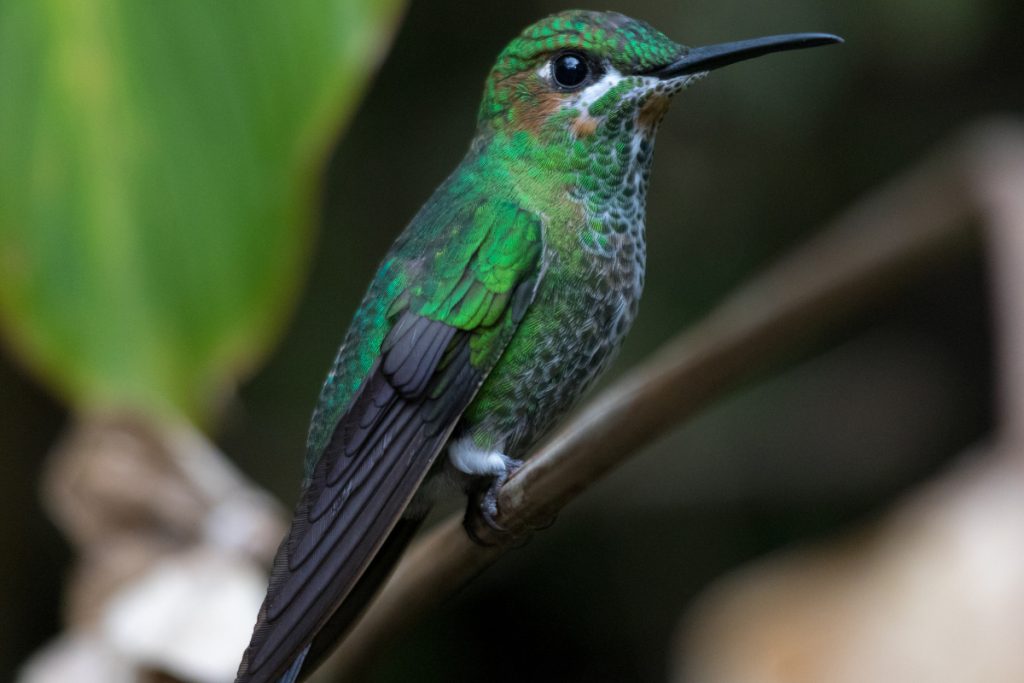
Related post to read about Top Hummingbird Feeders.
- Key Takeaways
- What Is A Hummingbird's Diet?
- A Daily Dose of Hummingbird Dietary
- Nectar – The Primary Source of their Food
- Tiny Insects Provide a Nutrition Boost
- Other Occasional Foods
- Nutrition to Match Their High-Speed Lifestyle
- Hummingbirds Behaviours for Feeding
- Diet Dangers: Consequences of Nutritional Deficiencies
- The Delicate Dance of Diet
- Final Thoughts
- Frequently Asked Questions (FAQs)
- Q: What are hummingbird feeders commonly filled with?
- Q: What percentage of a hummingbird's diet comes from flower nectar?
- Q: How does natural nectar compare to the sugar solution in feeders?
- Q: Which are some popular flowers that hummingbirds visit?
- Q: What else constitutes hummingbird food besides nectar?
- Q: What precautions should be taken when feeding hummingbirds using sugar water?
- Q: Are there any specific species of hummingbird that require more protein in their diet?
- Q: What serves as a source of protein for hummingbirds?
- Q: Should hummingbird feeders contain fruit juices or artificial sweeteners?
- Q: Can hummingbirds get nutrients from fruits?
- Q: How can one attract more hummingbirds to their garden?
- Q: Is it safe to add dye to hummingbird food?
- Q: How often do hummingbirds typically feed?
- Q: Do all species of hummingbirds have the same dietary needs?
- Q: What is the main source of food for the Broad-tailed Hummingbirds?
- Q: How do backyard birders ensure a healthy diet for wild hummingbirds?
- Q: How do the feeding habits of captive hummingbirds differ from wild ones?
- Q: What are the consequences if hummingbirds don't get a proper diet?
- Q: Can hummingbirds consume extra sugar water during colder periods?
- Q: Do hummingbirds remember where to find their food sources?
- Useful Links:

What Is A Hummingbird’s Diet?
Hummingbirds have a unique diet that reflects their incredibly high metabolism and energetic lifestyle. Their diet consists primarily of nectar from flowers, which provides 60-80% of their nutritional intake.
Hummingbirds use their specialised long tongues to drink the sugary nectar that fuels their high energy needs. They also consume small soft-bodied insects, which comprise about 10-30% of their diet.
Insects provide essential proteins, amino acids, vitamins and minerals that hummingbirds cannot get from nectar alone. Hummingbirds may supplement their diet with additional foods like tree sap early in spring, pollen for protein, or small amounts of fruit.
Due to their rapid metabolism, hummingbirds have to eat frequently throughout the day, consuming up to half their body weight in nectar each day.
Their diet allows them to power energy-intensive activities like hovering flight, courtship displays, migration, defending feeding territories and much more.
It’s pretty amazing what these tiny birds can do fueled on nectar and bugs alone! Now, let’s dive in and take a closer look at the details…
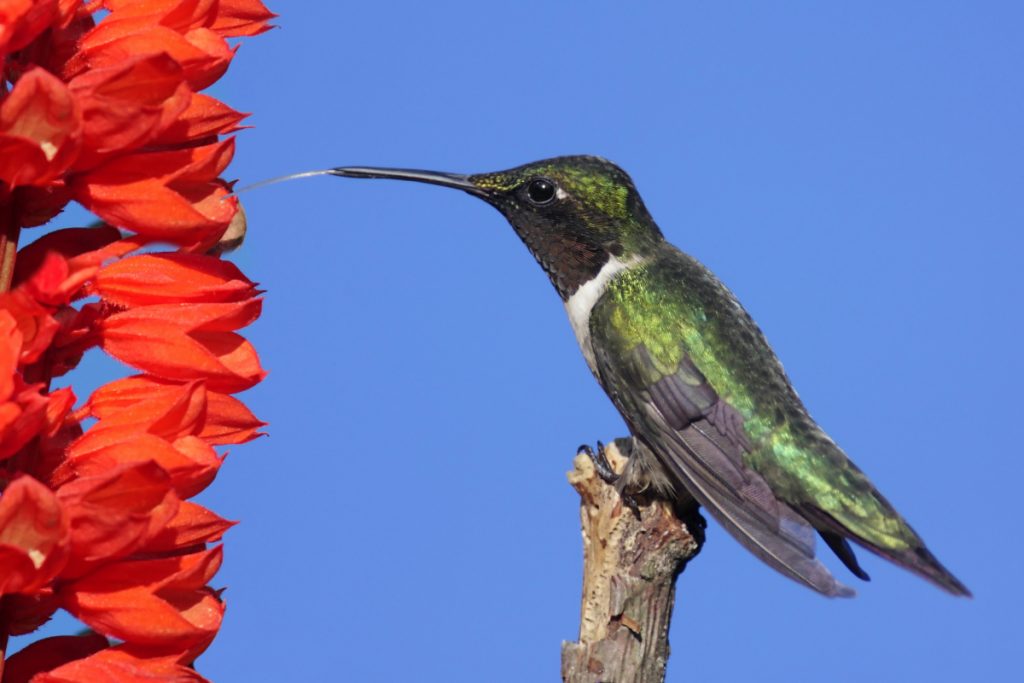
A Daily Dose of Hummingbird Dietary
The key to appreciating the hummingbird diet is grasping how incredibly rapid their metabolism is.
Their hearts pump at up to 1,260 beats per minute – that’s 20-25 pulses per second! This allows oxygen and energy to be delivered at astonishing speeds.
To put their dietary needs into perspective, an average hummingbird has to consume 40-100% of their total body weight in nectar each day.
For a 3-5 gram hummer, this means taking in 1-5 grams of nectar daily. Converted into household units, they drink roughly 0.2 – 1.5 ounces of nectar per day – nearly half their weight in fluid ounces!
With such a high metabolism, hummingbirds need to eat almost constantly to avoid starving. They have to visit hundreds of flowers or feeders daily to get enough to eat. Imagine having to eat a full meal every 15 minutes! It’s exhausting just thinking about it.
So what are the main components of their diet that provide all this vital energy?

Nectar – The Primary Source of their Food
The majority of a hummingbird’s calories – anywhere from 60-80% – comes from consuming floral nectars. They use their specialised long tongues to slurp up the sugary solution from blossoms.
Some interesting tidbits about the nectar itself:
- It’s primarily sucrose, glucose, and fructose.
- Concentration in flowers is generally 25-40% sugar compared to 10-20% in artificial feeders.
- The dilution and volume varies by flower species, time of day, and environmental factors.
- Hummingbirds have evolved digestive systems to efficiently absorb sugars. Their poop is nearly carb-free!
- They prefer nectars with higher sugar content when given options.
The amount of nectar hummingbirds consume daily can vary based on their:
- Size: smaller hummers need relatively more calories.
- Activity level: more time buzzing around means more fuel is required.
- Age: rapidly growing young hummingbirds need more energy.
- Season: colder weather and migration ramp up food needs.
So, in addition to their body size, the intensity of their active lifestyle has a big impact on their appetite.
A hummingbird spends most of its day engaged in energetically expensive activities like defending territories, performing courtship dances, migrating long distances, and, of course, accessing nectar supplies.
Let’s face it; the expression “busy as a bee” should really be “busy as a hummingbird!”

Tiny Insects Provide a Nutrition Boost
While nectar gives hummingbirds the carbohydrates they crave, flower juice lacks proteins, vitamins, minerals, and fats. How do these nectarivores get the essential dietary nutrients they need?
By munching on insects and spiders!
Adult hummingbirds get 10-30% of their daily calories, capturing tiny invertebrate prey. They prefer tiny, soft-bodied insects like fruit flies, gnats, aphids and spiders that are easily digestible.
Their ingenious method of insect-hunting involves flying in loops and dive-bombing swarms to snatch up mouthfuls at a time. No need to waste time chasing a single fly!
The proportion of insects in their diet tends to be higher for certain species and life stages with increased protein requirements, such as:
- Rufous and Black-chinned hummingbirds
- Nestlings and fledglings
- Females during breeding and egg production.
For mother hummingbirds, the surge in protein from insects is critical for creating eggs. So, while nectar keeps her fueled for flight, bugs provide the raw materials for new life!
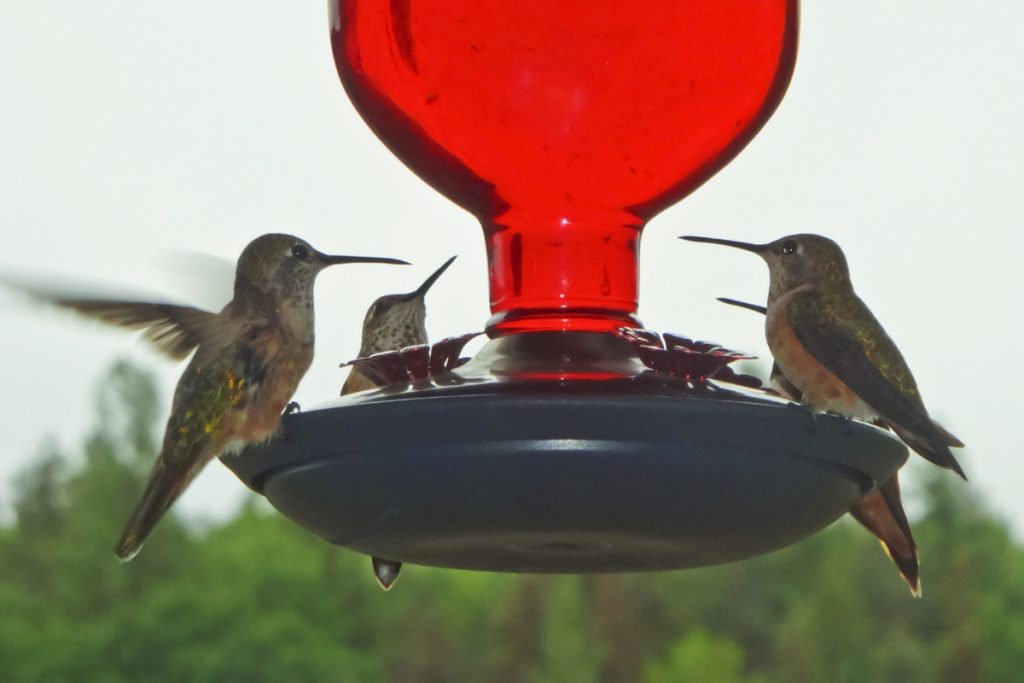
Other Occasional Foods
Beyond whizzing between flowers and snagging insects, hummingbirds have a couple of other tricks up their sleeve for acquiring sustenance:
- Sipping tree sap: provides an early springtime source of sugar before flowers bloom
- Licking pollen: adds supplemental protein, vitamins, minerals
- Eating fruits: Not a mainstay, but occasional banana bites provide carbs.
So their typical dining options are like a nectar drink, an insect protein, and the occasional sweet fruit!
Next, let’s look at how all these dietary elements come together to meet hummingbirds’ nutritional needs.

Nutrition to Match Their High-Speed Lifestyle
These active aerial acrobats need a dense concentration of nutrition packed into their minuscule meals. A hummer’s daily nutritional requirements include:
Calorie Count
- An average of 825 calories per day for a 5-gram bird.
- Up to 400 calories may be burned per hour of hovering!
- Smaller species need relatively more calories.
- Colder weather, migration and breeding increase requirements.
To meet these extreme energy needs, hummingbirds cleverly supplement their sugary nectar intake with higher-calorie insects and tree sap. This combination helps them avoid starvation.
Carbs Galore For Fuel
- Nectar gives them about 0.8 calories per gram of simple sugars
- Up to 2 grams of carbohydrates may be consumed per hour
- Nearly 100% digestion efficiency – their pee contains no sugar!
This provides the bursts of fuel needed for their aerial feats.
Protein Packed Eats
- Insects provide essential amino acids for growth and egg production
- Spiders and larvae especially pack a protein punch
- Requirements range from 15-20% of total calories.
Without sufficient protein, nestlings can’t develop properly. So, mama hummingbirds ensure their young get sufficient insect meals.
Hummingbirds Vitamins and Minerals
- Micronutrients like calcium, iron, and antioxidants promote good health.
- Calcium is particularly key for proper eggshell formation.
- Tree sap, pollen, and select insects provide concentrated sources.
A diversity of food keeps their nutrient levels topped up!
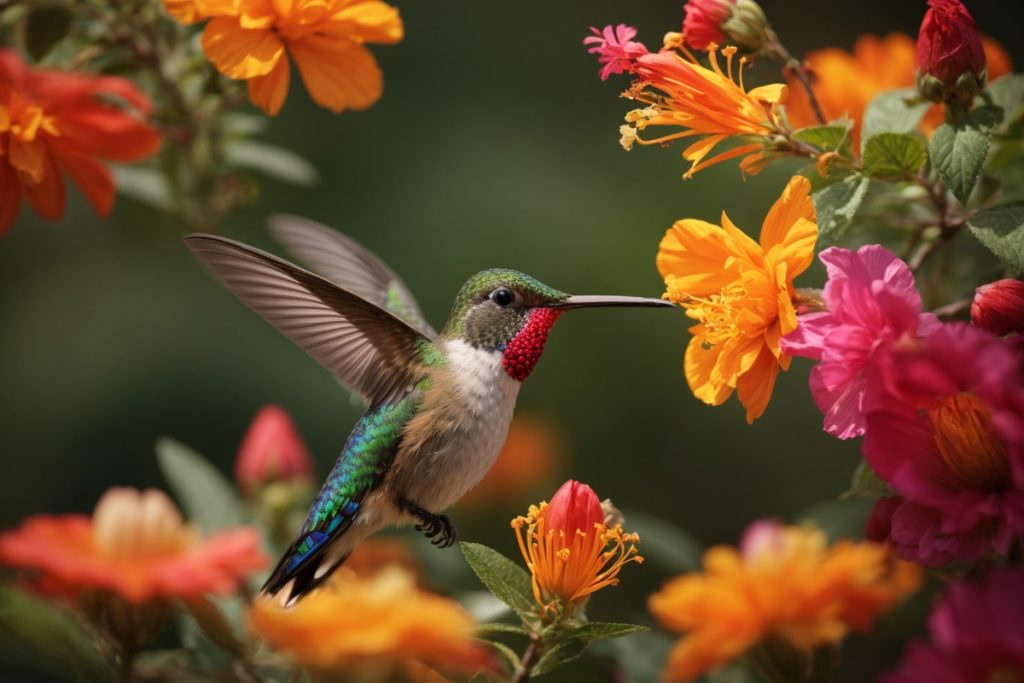
Hummingbirds Behaviours for Feeding
From slurping sap to trap-lining between flowers, hummingbirds have many clever adaptations to get the food they require:
- Tongue tube: Their long, forked tongues have tubes for nectar and grooves that lap up sap.
- Precision flying: They precisely hover and manoeuvre to dip into thousands of blossoms.
- Spatial memory: They remember the locations of reliable, nectar-rich flowers.
- Competition: Dominant birds chase competitors away from the best food sources.
- Torpor: They conserve energy by lowering their metabolism and body temperature at night.
These evolutionary tricks help maximise the calories they can consume while minimising energy expenditure.
But what happens if a hummingbird’s diet is insufficient or poor quality?
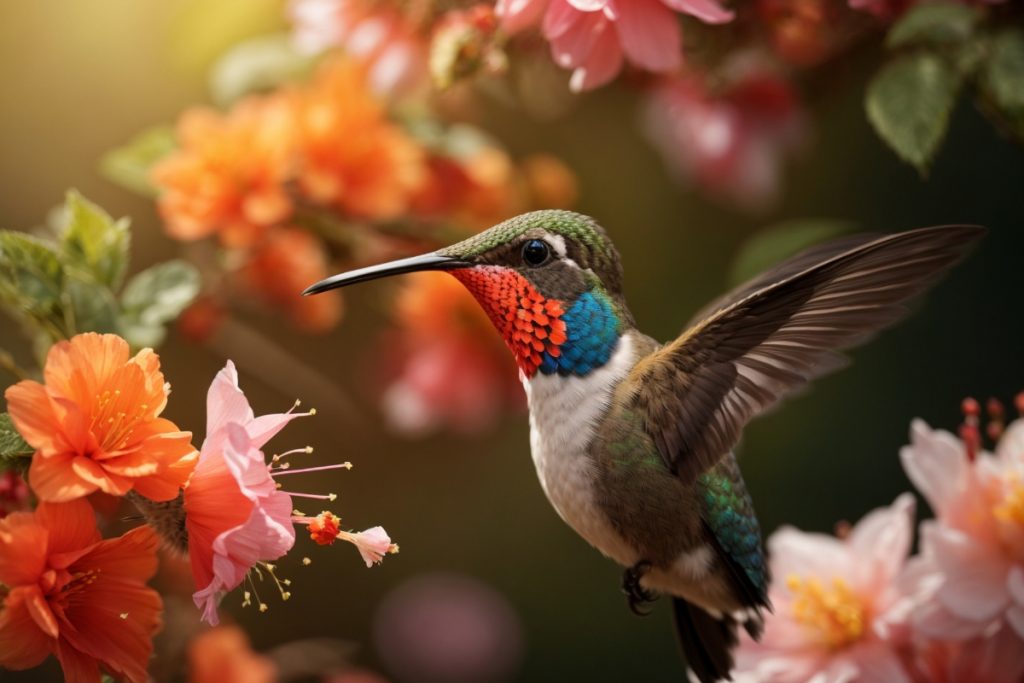
Diet Dangers: Consequences of Nutritional Deficiencies
With such a frenetic lifestyle, hummingbirds need a dense supply of nutrition to stay healthy and thrive. If their dietary needs aren’t met, it can severely impact their fitness:
- Low energy reserves: insufficient hovering, courtship and escaping predators
- Developmental problems: chicks may be underweight with physical impairments
- Limited fat storage: inability to survive migration or cold periods
- Reduced reproduction: females produce fewer and lower-quality eggs
- Increased disease: susceptibility to infections goes up with malnutrition
- Behaviour issues: lethargy, aggression over food, poor habitat choices
- Shortened lifespan: chronic nutritional stress reduces survival.
Fortunately, these adaptable birds are resilient. With adequate floral resources and occasional supplementation, they can bounce back from periods of scarcity.
The Delicate Dance of Diet
Well, we’ve covered a lot of ground exploring the dietary world of hummingbirds! Here are the key insights:
- Their exceptionally rapid metabolism requires frequent feeding on sugar-rich nectar and high-protein insects.
- They’ve evolved specialised tools and behaviours for harnessing floral energy supplies.
- Smaller size and colder weather increase their nutritional demands.
- Nesting females require extra nutrients like calcium and protein.
- Inadequate nutrition severely impacts their fitness and survival.
- But their adaptability helps them meet the challenges of their active lifestyle!
Final Thoughts
The interplay between diet, energy budgets, and ecological relationships makes hummingbird nutrition a fascinating and complex subject. Hopefully, this provided a helpful overview of how these captivating birds get the fuel they need to buzz through each day!
As always, thanks for reading. Let me know in the comments if you have any other hummingbird diet questions you’d want me to answer or explain further.
Till next time, bye for now!

Frequently Asked Questions (FAQs)
Q: What are hummingbird feeders commonly filled with?
A: Hummingbird feeders are commonly filled with sugar water, which mimics the nectar from flowers that hummingbirds naturally consume.
Q: What percentage of a hummingbird’s diet comes from flower nectar?
A: Anywhere from 60-80% of a hummingbird’s calories come from consuming floral nectars.
Q: How does natural nectar compare to the sugar solution in feeders?
A: Natural nectar in flowers generally contains 25-40% sugar, whereas artificial feeders might have a concentration of 10-20% sugar.
Q: Which are some popular flowers that hummingbirds visit?
A: While the article doesn’t list specific popular flowers, hummingbirds are attracted to nectar-rich blooms, especially tubular flowers.
Q: What else constitutes hummingbird food besides nectar?
A: Besides nectar, hummingbirds consume tiny insects, spiders, tree sap, and occasionally fruits like bananas for essential nutrients.
Q: What precautions should be taken when feeding hummingbirds using sugar water?
A: When preparing sugar water for hummingbirds, one should use white cane sugar without any artificial sweeteners, food colouring, or dyes. A common ratio is 1 part white sugar to 4 parts water.
Q: Are there any specific species of hummingbird that require more protein in their diet?
A: Yes, species like the Rufous hummingbird, Black-chinned hummingbird, and Ruby-throated Hummingbird may require more protein, especially during breeding and egg production.
Q: What serves as a source of protein for hummingbirds?
A: Insects and spiders serve as a primary source of protein for hummingbirds. They might consume insect eggs, fruit flies, gnats, and aphids.
Q: Should hummingbird feeders contain fruit juices or artificial sweeteners?
A: No, fruit juices and artificial sweeteners should be avoided in hummingbird feeders. Only a mixture of granulated cane sugar and water should be used.
Q: Can hummingbirds get nutrients from fruits?
A: Yes, on occasion, hummingbirds might consume juicy fruits like bananas to get additional carbohydrates.
Q: How can one attract more hummingbirds to their garden?
A: Planting native plants, especially native flowers and tubular flowers, can attract more hummingbirds. Creating a hummingbird garden with nectar-rich blooms is beneficial.
Q: Is it safe to add dye to hummingbird food?
A: No, it’s not recommended to add dye or food colouring to hummingbird food. It can be harmful to the birds.
Q: How often do hummingbirds typically feed?
A: With their high metabolism, hummingbirds need to feed almost constantly and might visit hundreds of flowers or feeders daily.
Q: Do all species of hummingbirds have the same dietary needs?
A: While all hummingbird species primarily rely on nectar for energy, their dietary needs can differ, especially across the more than 300 species. Tropical hummingbirds might have different diets compared to those in North America.
Q: What is the main source of food for the Broad-tailed Hummingbirds?
A: The article mentions the dietary habits of hummingbirds in general, but based on knowledge, Broad-tailed Hummingbirds, like most hummingbirds, rely heavily on nectar from flowers and supplement with insects for protein.
Q: How do backyard birders ensure a healthy diet for wild hummingbirds?
A: Backyard birders can ensure a healthy diet for wild hummingbirds by providing clean sugar water solutions in feeders, avoiding artificial sweeteners, and planting nectar-rich native flowers in their gardens. The use of chemicals while planting should also be avoided.
Q: How do the feeding habits of captive hummingbirds differ from wild ones?
A: Captive hummingbirds might rely more on prepared diets provided by their caretakers, whereas wild hummingbirds frequently move from flower to flower and source their food from the environment.
Q: What are the consequences if hummingbirds don’t get a proper diet?
A: Insufficient nutrition can lead to low energy reserves, developmental problems, reduced reproduction, increased disease susceptibility, and even shortened lifespan in hummingbirds.
Q: Can hummingbirds consume extra sugar water during colder periods?
A: Yes, during colder weather and migration, hummingbirds ramp up their food intake. Extra sugar water can help them meet their increased energy needs.
Q: Do hummingbirds remember where to find their food sources?
A: Yes, hummingbirds have excellent spatial memory and remember the locations of reliable, nectar-rich flowers and feeders.
Useful Links:
Related Posts to Read:
- Do Hummingbirds Beaks Open When Feeding?
- The Mysteries of Hummingbird Flight.
- 6 Fascinating Facts About Hummingbird Sizes.
- Ruby-Throated Hummingbird Migration Map.
- Where Do Hummingbirds Go When It Rains?
- How Much Does A Hummingbird Eat Per Day?
References:
- About Hummingbird (Link).
- Greenewalt, C. H. (1960). Hummingbirds. New York: Doubleday. Google Scholar.
- Carey C. The impacts of climate change on the annual cycles of birds. Philos Trans R Soc Lond B Biol Sci. 2009 Nov 27; 364(1534):3321-30. doi: 10.1098/rstb.2009.0182. PMID: 19833644; PMCID: PMC2781852.
- Rico-Guevara A, Rubega MA, Hurme KJ, Dudley R. Shifting Paradigms in the Mechanics of Nectar Extraction and Hummingbird Bill Morphology. Integr Org Biol. 2019 Jan 2;1(1):oby006. doi: 10.1093/iob/oby006. PMID: 33791513; PMCID: PMC7671138.
- Tyrrell LP, Goller B, Moore BA, Altshuler DL, Fernández-Juricic E. The Orientation of Visual Space from the Perspective of Hummingbirds. Front Neurosci. 2018 Jan 30;12:16. doi: 10.3389/fnins.2018.00016. PMID: 29440985; PMCID: PMC5797624.
- Hummingbirds Sighting (Journey North Map).
- About Hummingbird’s Characteristics.
